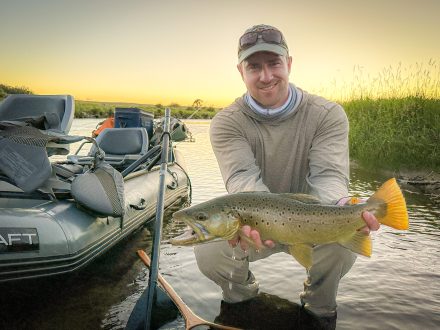One of the greatest parts of the fishing calendar is upon us: hopper season! It always baffles me that the same streams packed bank to bank with anglers during stonefly season are nearly devoid of people during hopper season, although the fishing is remarkably similar. Big surface eats, large fish, sunshine, and wet wading make for some of the most enjoyable trout fishing on the calendar. Below are several tips that may help you maximize your time on the water during this magical time of year. Enjoy, Chad Agy Presents: Tips for Hopper Fishing
Go Single-Point
Take off the damned dropper! You can literally catch fish with nymphs all year long. Why would you nymph during one of the best times of the year to get a big ol’ bucknasty to rise to a large dry fly? Now, there is a time and place for the dropper. Early in the summer when fish might not really be on big foam, a dropper may increase the action exponentially, and is a valid technique in that situation. But when the fish are really hunting terrestrials, all the dropper does is decrease the number of big, sexy dry fly eats that you’ll get to witness, as a proportion of trout will elect to eat the dropper instead.
But there is another advantage in taking off the dropper. Hoppers are most effectively fished single-point. In many streams, trout will literally hang out in the grass, waiting for a big, proteinaceous meal to drop into the water from above. Good luck getting your hopper into the right spot under the grass with a foot or two of monofilament dangling behind it. Any deficit in fish numbers that may occur due to a lack of dropper can be made up through proper single-point hopper fishing, deep in the grassy banks.
Go Big or Go Home
Hopper season is one of several times of year when the biggest, baddest trout in the river become just a bit more vulnerable. A two-foot brown trout is simply more likely to come out of its lair to inhale a big chunk of meat than it is to pick off a tiny sow bug or mayfly nymph. Chances at these big trout are maximized by using truly massive terrestrial patterns. Leave the ants and beetles at home, and tie on a size 6, size 4, or even a size 2 hopper. As the hopper whizzes by a cut bank at mach speed, something big is more likely to catch the attention of a fish hanging several feet below. Don’t be afraid to intentionally slap the water with the hopper. This isn’t the time for delicate presentations and 6x. Giant clumsy hoppers create a ruckus when they fall into the stream, and by smashing the fly on the water, you are ringing the dinner bell.
Rope ‘em
On that note, this is the time for big lines to match the big flies. I usually fish hoppers with 0x, and I never go below 2x this time of year. When the fly is potentially a couple inches long, a lighter tippet will result in lost flies and lost fish. I promise, the fish won’t care about tippet size with flies this big! Hoppers are the streamers of the sky. And when the river’s final boss decides to eat a hopper, you’ll be happy that you’ve got it on some rope. Thicker tippet also allows for quick, efficient battles that are particularly important during the late summer, when water temperatures are at their apex, and a drawn-out fight could result in increased trout mortality rates.
Get Creative
It seems that nearly everyone on the river during late summer is fishing a Chubby Chernobyl of some variety, and for good reason. Those things definitely work. Since coming on to the scene over a decade ago, they have taken August/September fishing by storm. But I’ve noticed that some fish are getting wise to these patterns, and I’ve seen more and more refusals. Don’t be afraid to experiment and try some patterns that others aren’t using. It doesn’t have to be anything crazy, just a little different. Personally, two of my favorites are tan Fat Alberts and the Panty Dropper Hopper.
Debarb Your Hook, Save a Life
While always a good practice, debarbing hooks on terrestrials is especially important. Debarbing a size 18 pheasant tail might not have a profound effect on fish mortality. A big terrestrial hook on the other hand, poses a greater risk to fish. Unfortunately, a good hopper hook-set can result in some deep takes. In New Zealand, fishermen are trained to mentally say “God save the Queen” before setting the hook on a big dry fly take. This is particularly important with terrestrials in order to prevent the fish from spitting the fly. The large hooks on these flies can easily penetrate the lingual artery or a gill raker with this delayed hook-set practice. A debarbed hook will rarely result in the type of bleeding that inevitably results in a trout’s death.
There you have it! Now go out and enjoy some of the year’s best dry fly fishing. The first killing frosts of fall will be here before we know it. Terrestrial season never lasts quite long enough.















